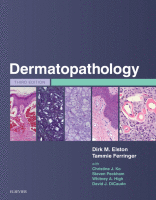Physical Address
304 North Cardinal St.
Dorchester Center, MA 02124

1 Electrocautery Keratinocytes show marked parallel vertical elongation Homogenization of the collagen 2 Gelfoam Blue-purple, arabesque, netlike pattern with surrounding granulomatous reaction 3 Aluminum chloride Epidermal effacement and horizontal fibrosis consistent with scar and underlying light gray-blue granules, often in…

1 Desmosome A classic desmosome showing the following features: (1) uniform gap of 20–30 nm between the apposed trilaminar plasma membranes with an intermediate line (arrow) in this gap; and (2) sharply delineated dense plaques into which tonofibrils (F) converge. 2…

You’re Reading a Preview Become a Clinical Tree membership for Full access and enjoy Unlimited articles Become membership If you are a member. Log in here

It is important to distinguish cutaneous metastases, particularly metastatic adenocarcinoma, from primary adnexal tumors of the skin. Adenocarcinoma metastatic to the skin is commonly of breast or lung origin. Focal areas of glandular differentiation may be highlighted with a mucicarmine…

Cutaneous B-cell lymphoproliferative disorders The primary cutaneous B-cell lymphomas share some histologic features with their nodal counterparts, but in many cases represent distinct clinicopathologic entities with significant clinical, immunophenotypic, molecular, and prognostic differences from their extracutaneous counterparts. In general, primary…

Cutaneous T-cell lymphoma and NK-cell lymphoma Mycosis fungoides Patch stage Key Features Lymphocytes “line up” along the dermal–epidermal junction (simulates vacuolar interface dermatitis, with a “lymphocyte in every hole”) Large dark lymphocytes with irregular nuclear contours and perinuclear haloes (“lump…

Angiokeratoma Key Features Hyperkeratosis Acanthosis Ectatic, thin-walled vessels in contact with the epidermis Resembles a “bloody seborrheic keratosis” Lymphangioma Key Features “Frog spawn” clinically Similar to angiokeratoma with lymph in vessels, but few erythrocytes D2-40+ Nevus flammeus Key Features Dilated…

Neurofibroma Key Features Loose arrangement with pale myxoid stroma Haphazard spindle cells with small wavy or S-shaped nuclei Mast cells are numerous Neurofibromas may occur as solitary lesions. Multiple widespread neurofibromas characterize neurofibromatosis (von Recklinghausen disease) in which they are…

Fat Lipoma Key Features Well-circumscribed tumor with a thin capsule Mature lipocytes Inconspicuous septae Lipomas typically present as asymptomatic, mobile, soft nodules in the deep soft tissue or subcutis. Histologically, they are thinly encapsulated tumors composed of sheets of mature…

Dermatofibroma Key Features Interstitial spindle cell proliferation Collagen trapping Overlying platelike acanthosis Follicular induction common Ringed lipidized siderophages or perivascular collagen donuts may be present Factor XIIIa+ CD34− All dermatofibromas demonstrate a proliferation of fibrohistiocytic cells. A curlicue pattern is…